A long standing alliance between Japan Airlines and The Boeing Company faltered when the airline invested in 31 Airbus A350’s, over Boeing’s upcoming 777X planes. After technical frustrations with the Boeing 787 Dreamliner and delayed release dates for the new 777X, Japan Airlines opted out for the A350’s. As a bonus, the company anticipated lower costs with Airbus’s discounts and a quicker delivery date. However, JAL’s decision is accompanied by high switching costs which may detract from the overall benefit of the switch.
Along with purchasing a new fleet, Japan Airlines will require a significant and ongoing investment in maintenance and training.1 The company will be obligated to hire Airbus pilots, mechanics, and train air flight personnel to handle operational changes. Procedures as simple as folding in supercomputers, a feature on the A350’s, will require training of current, and new staff. Although seemingly insignificant, the company could save money on the additional costs associated with switching suppliers. In addition to expensive mechanical changes, JAL also sacrificed any loyalty packages or discounts they acquired with The Boeing Company throughout the years.
Although Airbus is an appealing alternative supplier for the recently problematic Boeing planes, the associated switching costs appear more expensive than any savings the A350’s will provide.
1: Stock, Kyle. “How Japan Airlines Flexed Its Negotiating Muscles.”BloomberBusinessweek. N.p., 07 Oct. 2013. Web. 07 Oct. 2013
Additional Citations
Clark, Nicola, and Hisako Ueno. “Japan Airlines Deal With Airbus Is Blow In Boeing Stronghold.” The New York Times. N.p., 07 Oct. 2013. Web. 07 Oct. 2013.
Figure 1: Web. 07 Oct.2013.

